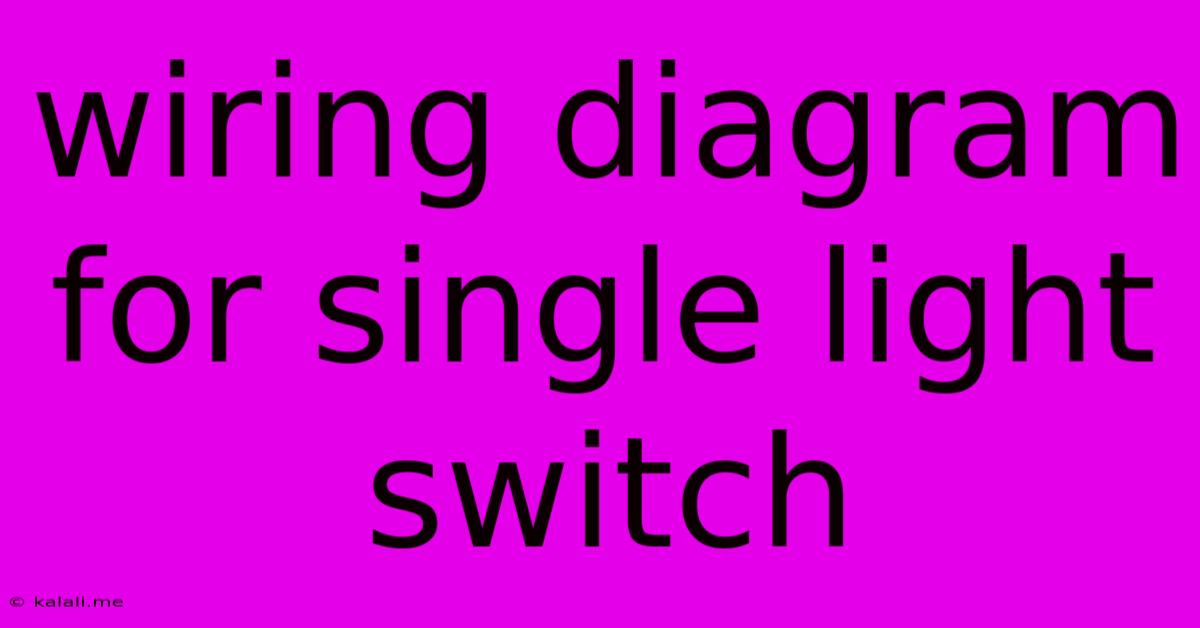Wiring Diagram For Single Light Switch
Kalali
Jun 03, 2025 · 3 min read

Table of Contents
Understanding Single Light Switch Wiring Diagrams: A Comprehensive Guide
Meta Description: This guide provides a clear explanation of single light switch wiring diagrams, covering different types of switches, wiring methods, and troubleshooting tips for DIY homeowners and electricians. Learn how to safely wire a light switch and understand common wiring configurations.
Wiring a single light switch might seem daunting, but with a clear understanding of the wiring diagram, it's a manageable DIY project. This article breaks down the process, explaining the different components and how they connect to safely and effectively control your light fixture. Understanding basic electrical wiring is crucial for any homeowner, and this guide provides a solid foundation. We'll cover various scenarios, including those using different types of switches and troubleshooting common issues.
Types of Single-Pole Light Switches
Before diving into diagrams, it's essential to understand the different types of single-pole switches you might encounter:
-
Standard Single-Pole Switch: This is the most common type, controlling a light from one location. It uses two terminals – one for the power source (hot wire) and the other for the light fixture (load wire). The neutral wire typically passes through without connection.
-
Dimmer Switches: These switches allow you to adjust the brightness of your light fixture. While the basic wiring principle remains the same, dimmer switches require specific compatibility with your light bulb type (incandescent, LED, CFL).
-
Decora Switches: These switches offer a more modern aesthetic, featuring a sleek, rectangular design. The wiring is identical to a standard single-pole switch.
-
Smart Switches: These technologically advanced switches offer features such as remote control, scheduling, and integration with smart home systems. While they often have more complex internal components, the basic wiring connections to the power and load remain similar to standard switches.
Standard Single-Pole Switch Wiring Diagram
This is the most common scenario. The diagram typically shows:
- Live Wire (Hot Wire): This is the wire carrying the electrical power from your circuit breaker. It's usually black or red.
- Neutral Wire: This wire completes the circuit and is usually white. It typically connects directly to the light fixture and bypasses the switch.
- Load Wire (Switched Hot Wire): This is the wire connecting the switch to the light fixture. It's usually black or red. This wire is controlled by the switch.
- Ground Wire: This wire ensures safety by providing a path for stray electrical current to the ground. It's usually bare copper or green. It connects to the switch's grounding terminal and the light fixture's grounding terminal.
Diagram Representation (simplified text version):
Power Source (Hot Wire) ---[Switch (Common Terminal)]--- Light Fixture (Load Wire)
|
|--- Neutral Wire --- Light Fixture
|
|--- Ground Wire --- Light Fixture
Important Considerations:
- Always turn off the power at the breaker box before attempting any wiring. This is crucial for safety and preventing electrical shock.
- Identify the wires correctly: Use a voltage tester to confirm the "hot" wire before working.
- Use appropriate wire connectors (wire nuts): Ensure all connections are secure and properly insulated.
- Refer to the instructions provided with your specific switch: Different brands and models may have slightly varying instructions.
Troubleshooting Common Issues
- Light doesn't turn on: Check the breaker, the bulb, the wiring connections at both the switch and the light fixture. Verify that the correct wires are connected to the correct terminals on the switch.
- Switch feels hot: This indicates a loose connection or a faulty switch. Turn off the power and carefully examine the wiring. Replace the switch if necessary.
- Flickering lights: This can be caused by loose connections, a faulty bulb, or issues with the circuit itself.
By understanding the basic principles of single light switch wiring diagrams, you can confidently tackle this common DIY project. Remember safety is paramount; always prioritize safety and consult a qualified electrician if you are unsure about any aspect of the process. This knowledge provides a valuable skill for any homeowner who desires to maintain and improve their home's electrical system.
Latest Posts
Latest Posts
-
Can I Write Stealth Startup Internship In My Resume
Jun 05, 2025
-
What Is The Difference Between Rallentando And Ritardando
Jun 05, 2025
-
Can I Cook 2 Hams At The Same Time
Jun 05, 2025
-
How Do You Say Later On In Spanish
Jun 05, 2025
-
6 Year Old Not Listening At School
Jun 05, 2025
Related Post
Thank you for visiting our website which covers about Wiring Diagram For Single Light Switch . We hope the information provided has been useful to you. Feel free to contact us if you have any questions or need further assistance. See you next time and don't miss to bookmark.